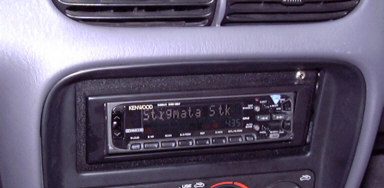|
Never Forget |
||||||||||
|
|
||||||||||
EngineTransmissionInteriorCar InformationThe Society of Automotive Engineers Car EnthusiastsCar Parts Vendors |
Interior StuffCar Stereo Installation
The head unit was pretty much a standard install. Any aftermarket Chrysler faceplate kit for 95 and later vehicles will do, as well as the factory Chrysler radio wire harness adaptors. (That little silver circle on the top right of the radio is a 3.5 mm stereo input jack that is wired to the "Aux" input of the Kenwood switching unit.) The ten-disc changer was mounted to the Chrysler six-disc changer mounting plate using rivets. The plate can be picked up from any local Chrysler dealership for about $40. I had to modify the plate to accommodate the Kenwood changer, as well as the forward console.
Notice that there is an auxilliary CD player installed below the ten-disc changer. I installed this so as to be able to conveniently play a single CD while leaving my 10-disc cartridge alone. Compass/Mini-Trip ComputerThey said it couldn't be done! When I bought my Dodge Stratus ES, I was looking for one of these little gadgets that would tell what kind of fuel economy the car was getting. Initially, I was told that such an option was only available on "luxury" cars like the Intrepid. I was bummed out, sure, but then I looked at the video that came with my car, and sure enough, it featured something called a Compass/Mini-Trip Computer (CMTC). I figured, well, it can't be that complicated a device, so I started doing research on installing one. Needless to say, every dealer I talked with said that either: the option was not available for cloud cars, or it was available but it was a factory install only (no chance of ever getting it to work without major modifications, or some nonsense). This simmered over about a year, until I finally found a decent parts guy at the local Chrysler dealership. He and I looked at the diagrams of this CMTC thingy and decided that the only thing I needed was to get the wiring into the device. Well, the wiring was actually pretty simple, if you know to look in Mitchell's CD-ROM wiring diagrams. So I ordered the part (and the entire instrument cluster hood and bezel, since the black part (bezel) I really needed was glued down to the gray hood cover.) I spliced into the wiring at the instrument cluster wire harness, connected the CMTC up, and it worked like a champ! And they said it couldn't be done!
Of course, I had to improvise on the wire plug going into the CMTC. The factory plug is not available, so I ended up using female pins from a serial cable to make the actual electrical connections into the CMTC module, and then RTV'ing the pins in place so they would be secured. I ended up using ordinary nylon plugs to connect the wiring from the CMTC to the car's wiring. Seems to work pretty good; has been going strong for a year now with absolutely no problems whatsoever. As stated before, I had to purchase an entire dash hood and bezel assembly. The instrument cluster bezel (black trim piece) provides the necessary structural support and makes the CMTC installation look professional. I suppose that one could modify their existing bezel to accept the CMTC (it's really quite small, about the size of a computer mouse), but that would involve a lot of work and/or money. The instructions and a listing of all parts needed for this modification can be found in the CMTC Installation page, which includes instructions on CMTC calibration and setting CMTC magnetic variance, in the How-To section. Automatic Headlamp-OnBack in '96, when I still owned a K-car, the Alaska Department of Transportation had this brilliant idea of requiring everyone driving on a road with a speed limit of 45 or greater to have their lights turned on. Such wonderful (yeah, right) bureaucratic thinking was eventually shot down. However, at the time, it looked like it would be inevitable, and so I rigged up a stupidly simple relay circuit that would have the same effect as turning on the lights for nighttime driving, and I put it into the old K-car. Well, I grew to like the idea of having the lights turn on, and when I got the Stratus, I decided to install the same circuit. The Stratus' circuit was a bit more involved than the K-car's. I ended up without the ability to switch on high-beams or the fogs, when this circuit was energized. This meant that I had to use the headlamp switch as before in order to use high-beams or fog lamps. The "optical horn" worked just fine, though. |
|||||||||
|
Chrysler, the Chrysler logo, Dodge, and Mopar are registered trademarks of Fiat Chrysler Automobiles. Other trademarks and logos are copyrighted by their various owners. This website copyright © 2000-2015 Thomas A. Vago. All Rights Reserved. |
This page last updated 5 July 2015. | |||||||||


